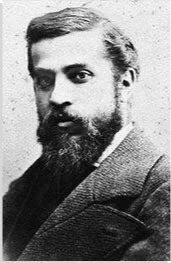
BARCELONA
The Architecture of Antoni Gaudi
Antoni Gaudi
Gaudi was a Catalan architect in the late 19th century. He’s famous for his work at the forefront of Modernism, his break from traditionally Gothic style, and his use of reclaimed matierials in his designs.
All but three of his works reside in Barcelona, but he is most famous for his still unfinished La Sagrada Familia, to which he dedicated his life. He obsessed over the building, having virtually no social life and spending his last few months living in his workshop inside the church.
In 1926 he was on his way for his morning prayer at Sant Felipe Neri when he was tragically struck by a tram. Because he was dressed like a beggar, he was simply left for dead for hours before a good Samaritan took him to a hospital. He received virtually no care once again and it wasn’t until the next day a priest recognized him as the famous architect. By then it was too late. He was buried two days later.

La Sagrada Familia
Carrer Mallorca, 401
Gaudi’s most famous work of art, this church is still unfinished after 140 years. People line up for blocks to get inside as it is the most famous and visited building in all of Spain. I suggest you buy tickets well in advance based on the season. Tickets go on sale up to 90 days early.
Casa Batlló
Passeig de Gràcia, 43
Originally built in 1877 on one of Barcelona’s most prominent streets, it was bought by Josef Batllo and slated to demolish. Gaudi as able to redo the entire facade and inside as well as update the building for the use of electricity and thus save the building. Casa Batllo is one of five modernist building on the block, all renovated at the same time by different architects.
Park Guell
Carrer Mallorca, 401
Originally known as a failed urbanization project, Park Guell is now a historical heritage site full of original Gaudi works, including the Gaudi Mansion, which he lived in for years until moving to his Sagrada workshop just months before his death. Covering almost 30 acres, it includes multiple buildings, original architectural elements, and parks.





